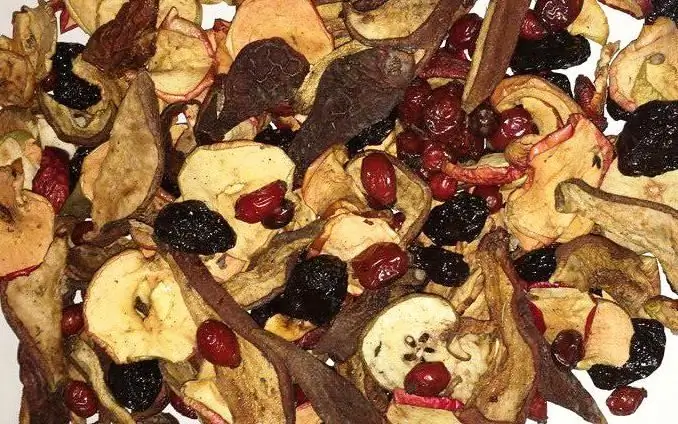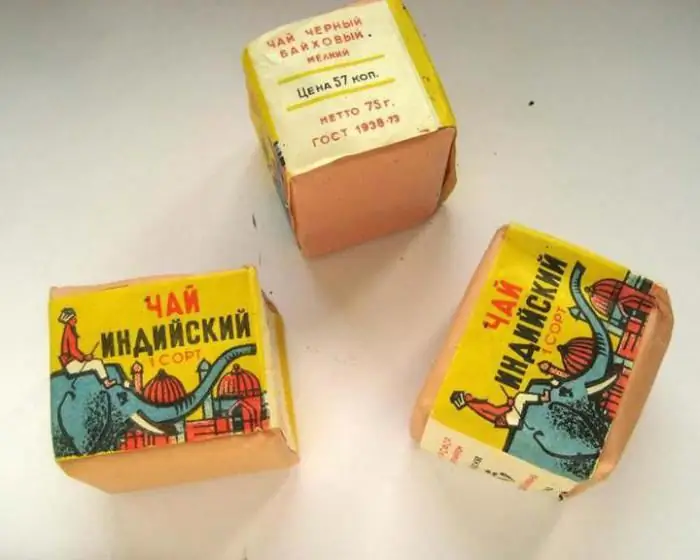2025 Author: Isabella Gilson | [email protected]. Last modified: 2025-01-23 12:50:38
Today, many people don't even know what scarcity is. But literally thirty years ago in the USSR, people stood in line for hours to buy products, the range of which left much to be desired. This is what our country was like in the seventies and eighties of the last century. It was at that time that the Soviet people for the first time could feel the taste of Indian tea. Today we will tell you all about black tea "with an elephant", which was considered one of the best products of a bygone era.
Own tea industry
Initially, there was only domestic Georgian tea in the USSR. It was a real breakthrough in the industrial industry, and the drink was even exported to other countries, where it became popular. That is why the authorities decided to expand production and switched from manual work to machine work, which caused a loss of its former quality, since mechanisms, unlike people, could not distinguish good tea leaves from bad ones. In the seventies, the tea industry in the USSR collapsed, the state suffered losses and began to decide what to do with it.do.

The appearance on the shelves of tea "with an elephant"
Many people who lived in the times of the USSR sadly recall those times when "the grass was greener and the sky clearer", and the products were of the highest quality, in comparison with them, even imported ones were useless. But many did not even suspect at that time that they were drinking tea, collected not on the territory of their beloved Motherland, but far beyond its borders.
It so happened that Georgian tea fell into disrepair, so the USSR entered into a tea supply agreement with countries such as Sri Lanka, Kenya, Tanzania, India and Vietnam. With its previous importer, China, which could also supply tea, our state quarreled and therefore did not use its services. So, in order not to lose face in front of their citizens, the factories began to pass off imported tea as domestic, bad Georgian leaves were added to it so that they would not be wasted. Since tea came in bulk in loose form, it was easy to do this, without loss. Initially, this scam went well, but still the "domestic" tea was replaced by the same Indian tea "with an elephant". The citizens really loved him.

The history of tea "with an elephant"
How did tea "with an elephant" appear on the shelves of domestic stores? The development of the recipe, according to some sources, belongs to the Irkutsk tea-packing factory, according to others, to the Moscow tea factory. But this is not so important now, and even then few people asked about the dataquestion. The main thing is that the recipe was so successful that the tea "with an elephant" was really distinguishable from all other drinks. This tea was distinguished not only by its bright and strong taste, but also by the packaging, which was specially developed in 1967, and Indian tea "with an elephant" went on sale in 1972.
Tea ingredients
But again, that was not real Indian tea, but a blend (mixture). This tea included varieties of Georgian, Madagascar, and Ceylon leaves.
Tea "with an elephant" was divided into the highest and first grade, their composition was significantly different. The first grade package contained only 15% tea from India, 5% from Ceylon, 25% from Madagascar, and as much as 55% of leaves from Georgia.
The highest grade is the highest, and therefore there was one third of real Indian tea in it, and two thirds belonged to Georgian.
Each of the varieties adhered to the requirements of GOST and TU, only the highest grade Darjeeling was added to Indian tea. This tea was produced in the factories of Moscow, Irkutsk, Ryazan, Ufa, Odessa. Each production had its own tasters, whose duties included compiling the necessary mixture of purchased varieties so that all the qualities correspond to the product (taste, aroma, smell, color and price). Each factory was already quite self-sufficient and had its own tea supply contracts with each country.

Package design
Since tea was produced in two varieties, they had to be somehow distinguished visually. So, on the packaging of the first grade, the elephant had a bluethe color of the head, and green on top grade tea. Over time, the design changed, and each of the factories had its own differences. There was only one thing: cardboard packaging, elephant.
What design did the "elephant" tea have? Consider the most memorable variations: the color of the packaging was both white and orange, but yellow is more familiar to us. The elephants themselves were also different, there were packages where one elephant with the trunk lowered down steps to the left, there were also three elephants walking in the same direction, and also with the trunk lowered. The most striking example of the drawing is an elephant, which, with its trunk raised, stands against the background of an Indian city, and the domes are clearly visible. All of the elephants listed above were ridden by a mahout.
Why do we remember the yellow packaging of tea more, where the elephant is against the background of India, and its trunk is looking up? The thing is that due to the popularity of tea, and sometimes its absence on the shelves, fakes often began to appear, where there was no smell from Indian tea, and most of the composition belonged to Turkish, terrible in quality. In this regard, citizens began to give preference to one type of packaging, which was rarely faked due to a richer pattern.

Symbol of the era
When reminiscing about the times of the USSR, the image of that tea, the same elephant, soft cardboard packaging brightly pops up. Along with many products of that era (take the same condensed milk), this tea remains recognizable even in the 2000s, and more than seventy percent of the population of the former Soviet Union can remember it.
Tea "with an elephant" (price for 50 grams -48 kopecks, and for 125 - 95 kopecks) was loved by everyone. The presence of this drink in the house spoke of the stable prosperity of the family.
But, like all good things, tea "with an elephant" once disappeared from the shelves. The USSR collapsed, and tea could still be found for some time, then it was simply swept off the shelves.

Brewing rules
Many housewives made a terrible mistake when white sticks were pulled out of a pack "with an elephant" and, mistaking them for garbage, they simply threw them away. After such a stripping, it was impossible to fully experience the taste of tea, since those sticks were tips (tea buds), and these raw materials are of the highest quality.
This tea is brewed in the same way as all other varieties. Pour the required amount of tea leaves into a teapot treated with boiling water, pour boiling water over it. Let it brew for at least ten minutes, you can dilute it with milk.

Elephant tea reviews
Many who remember that tea can find on the shelves of stores similar in design to products that say "The Same Tea". So, what do consumers say about the Soviet tea "with an elephant" and its modern prototype?
There are records of people rushing to buy this familiar product in order to feel nostalgic when they saw such a familiar product in the store. However, when brewing tea, nothing at all was found in common with the Soviet product.
There is an opinion that perhaps this is really the same recipe, it’s just that in Soviet times this tea was the best, andnow people are spoiled for variety, and they just didn’t like the long-forgotten taste.
They write that tea "with an elephant" is wonderfully remembered, and there was no more delicious drink at that time.
Recommended:
Compote mixture: composition, taste and method of compote preparation

Compote mixture is seasonal fruits dried in an oven or in an electric dryer, from which housewives cook compote in summer. Such blanks are very convenient to use, stored all year round. If you dry your favorite apples, plums, pears, apricots or peaches on your own in the summer, you can cook delicious and fragrant compotes all winter and spring
Recipe for preparation and composition of monastic tea from smoking. Price, instructions for use, reviews

Smoking is one of the most common bad habits of mankind. In the fight against it, smokers resort to a wide variety of methods and recommendations. This is no coincidence, because today it is no longer fashionable to be addicted. Unfortunately, many people have been smoking for more than five years. It is for this reason that many people fail to cope with addiction on their own. In our article, we will analyze not only the composition of monastic tea from smoking, but also its properties
Monastic anti-parasitic tea from nail fungus: composition, reviews, manufacturer, method of application

Monastic anti-parasitic tea from nail fungus, the composition and dosage of which we will reveal below, appeared not very long ago on sites with a bright "buy now" button. Against the background of many other herbal supplements, it is difficult to deny the benefits of this tea. But, despite the fact that our ancestors were treated with herbs, it is dangerous to use them without information about the optimal dosage and side effects
Calorie beef lung, composition and method of preparation

This unusual meat dish is quite a satisfying, he althy and nutritious snack. Recently, new and interesting recipes for preparing animal entrails have appeared in cooking. For example, lungs, kidneys, liver or hearts. Despite the fact that this dish is a little scary with its ingredients, boiled lungs or kidneys turn out to be insanely tasty, have a pleasant aroma and aftertaste
Rolls "Alaska": composition, method of preparation and benefits

Composition of "Alaska" rolls, tips for cooking them at home, the benefits of rolls in general and individual ingredients included in their composition

